While most tourists search out noble castles and museums crammed full of art on their trips to Italy, for me its all about the cheese. Okay, maybe some fruit and vegetables occasionally, but only because one cannot live on cheese alone. Believe me I’ve tried!
Luckily for a turophile like myself there is scarcely a scrap of Italy that is not famous for a local cheese (or at least should be). For the novice cheese addict, the following will provide a short primer on Italian cheese roughly organized by milk type and geographic location.
Southern Italy is home of the water buffalo and of course, mozzarella. Almost never served on its own, mozzarella in Italy finds its way into countless antipasti, such as the bruschetta and fried balls of bocconcini (tiny mozzarella morsels) we snacked upon in the piazza of Cortona.
Central Italy is the sheep belt; from Sardinia to Umbria small rounds of cheerfully painted pecorino (black is ash or squid ink, red, tomatoes or simply olive oil are common “coatings”) have been faithfully crafted for centuries, with each village home to a specific specialty. At our friend’s wedding in Umbria, we enjoyed Fiore Sardo (the “Flower” of Sardinia; robust, nutty, with a hint of smoke on the finish) and Formaggio di Fossa (a strange, wonderful cheese from the Marche that is wrapped in hay and buried in the ground for several months to ripen; pungent, slightly bitter and peppery, with a texture similar to wet sand). Aged pecorino is often big on flavor, short on nuance. The perfect accompaniment to a glass of full bodied white wine, like the Pinot Grigio “Sdricca” we enjoyed that night with dinner.
On the rocky, mountainous Atlantic coastline stretching northwards toward France, goat milk cheeses are plentiful. A culinary culture of economy, cheese in Liguria is seen more frequently as an ingredient rather featured on a cheese plate. We discovered that the famous ligurian pesto traditionally incorporates goat cheese, not Parmesan as is commonly instructed in American recipes.
A trip to Liguria would not be complete without their traditional take on the melted cheese sandwich, a chickpea fritter filled with ooey-gooey cheese, Farinata con stracchino.
If you are a true cheese lover, you simply must go to Northern Italy, which, completely coincidentally of course, was our next destination. Cows are king in the north, home to Parmesan and Grana Padano, as well as dozens and dozens of regional specialties. In Piedmont (which I would argue is the Gastronomic capital of Italy!) sheep and goats milk cheese gets equal footing as well. At our first stop in the wine and truffle crazy town of Alba, our gracious hosts at the Locanda del Barbaresco met us at the door with a glass of their own white wine Favorita (a grape only found in Piedmont) and a cheese plate.
Toma, was my favorite offering, a local specialty made from a blend of cow and goat milk and washed with a salty brine during its ripening to produce a dense, tangy, aromatic round 6 to 8 ounces in weight. Toma is the Piedmontese word for Tomme, French cheese terminology to describe a round cheese ranging in size from a few ounces (cutely described as a “Tomino” in Italy) up to a hefty twelve pounds. (Somewhat confusingly, another cheese called Tuma can also be found in Piedmont, which is a soft fresh cheese used for cooking.) Accompanying the Tuma were two fresh, crumbly cheeses made of cows milk and sheep’s milk respectively and Grissini, the Turinese bread stick present at virtually every meal except breakfast in Piedmont.
The next day at lunch in Barolo, we noticed an osteria offering a Piedmontese cheese plate as a secondi, ie (the main dish) of the lunch! Have I died and gone to heaven?
When the plate arrived it defied all my expectations; twelve hearty wedges of local cheese concentrically framing a pool of hazelnut-black currant mostarda (a condiment common to northern Italy flecked with mustard seeds for a spicy contrast to the sweetness of the fruit). Sadly, the Osteria couldn’t tell me the names of the cheeses, describing this masterpiece simply as a “typical, traditional cheeses from all over Piedmont”. Years of “work” tasting as many kinds of cheese as possible unfortunately did not allow me to recognize everything, but here is partial list from mildest to strongest: #1 Murranzano #2 Robiola di Roccoverno, #4 Raschera, #5 Taleggio, #6 Toma del Lait Brusc, #7 Grana Padana, #8 Bra, #9 Blu di Capra, #10 Testun al Barolo, #11 Saras del Fen (sorry I can’t tell you the rest, you will just have to visit Barolo and order the cheese plate!)
We discovered a source for true mountain cheese at our next stop in Vernante, a small town nestled into the Parco Nationale Alpine-Maritime famous for its Pinnochio murals. Our extremely hospitable host Christian at the Hotel Nazionale 1896 was directing us to the start of a hiking trail in the hamlet of Palanfré, when he off handly mentioned that we would pass by a local cheese farm. Sure enough, right at the start of the trail was Azienda Isola, a small two building farm with a promising sign: “Vendita Formaggi”.
Just a few minutes into the hike, a melodic ringing sound could be heard. As we crested the first rise the source of the ringing appeared high up on mountainside, the cows of Palanfré, peacefully munching mountain grasses! Eager to try the fruits of all that mastication, we finished the hike and entered Azienda Isola through the thick curtain of beads hanging from the doorway. The proprietor smiled and greeted us warmly, standing proudly behind her wares. With a bit of pigeon Italian and some French cheese terms “Lait cru?….Si!” we selected two of most interesting looking creations, an aged tome washed in the beer from Birrificio Troll down the road and an aged ricotta. Back at the hotel with some fresh figs and a bottle of Birrificio Troll Palanfre to accompany, we dug into the cheeses. The aged ricotta was wonderful. Rich, smooth texture, full milky flavor with a whiff of sweet dried hay and clotted cream on the finish, I had to resist eating the whole piece right there. The beer washed cheese was equally good and unique, a spicy pungent flavor and wet crumbly paste reminiscent of ricotta salata. At twelve euros a kilo, these cheeses were literally a steal. Amo l’Italia!
For those of you who are as obsessed with cheese as I am, check out the technically accurate if rather dry postings on Piedmontese Cheese by Giuseppe Zeppa on The Dairy Science Info website: http://www.dairyscience.info/cheeses-of-the-piedmont-region-of-italy.html

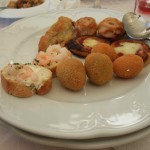
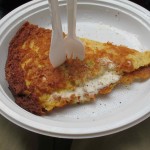
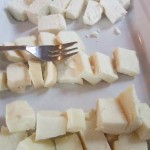
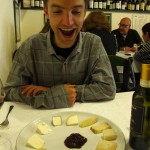
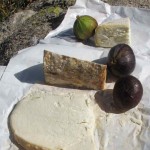
Leaving room for human error, I think we also visited the cheese mavenstry of Pananfre’ last year. Nancy likes her lunch, so I asked one of the dudes outnumbering their only customers in the cafe (down from the cheese shoppe) for a cheese sandwich a portar via on our hike up toward some lakes. One of the lads swung into action behind closed door-flaps, returning shortly with a briefcase-sized parcel wrapped in layers of paper. We tussled with the mountain to the site of a closed refugio, in the lee of which we sheltered from the gale to watch the clouds devour the mountain before of us. Un-wrapping the paninno we faced an entire loaf of bread, flat and crusty with about an inch of yellow cheese inside. Nancy could not open her mouth wide enough to really get a firm bite, so she proceeded bit by bit, like a pirahna eating a horse. When she tired of thrashing about and growling, in true St. Bernard fashion, she offered me a go at the thing. But I was afraid the bread was stronger than my elderly teeth, so I thought to lever the halves apart. What resulted was a cheese-topped pair of untoasted bruschette, about the size of manhole covers–very tasty and sustaining. What we learned is this: even if the cheese is good, never let a nineteen year-old boy make your lunch.
Hi Bill! Sounds like you also had quite a time up on that mountain. It’s experiences like this that we’ll remember for years to come. Hope you still are a cheese fan!